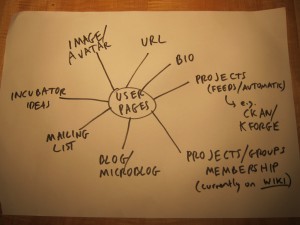
Introduction to digital planning
What is digital planning? Well it depends on who you speak to, there isn’t a standard answer. Different agencies approach digital planning in different ways and their planners would describe their roles in dissimilar terms as this presentation from Heather LeFevre demonstrates.
Below I’ve listed what I think are the 9 core aspects of digital planning, but first let’s set the scene by looking at traditional advertising account planning. You’ll notice that digital planning sometimes compares to traditional planning but is often quite different.
advertising account planning
Account planners are responsible for ensuring that the advertising produced by their agency is relevant to its target audience. They will work closely with consumers to identify their needs and preferences, but also research the client’s brand and the competitive landscape they are in. From this they will formulate a strategy based on their analysis and then brief their creative colleagues who will develop messages that support that strategy.
Digital planning also concerns the study of client and customer needs but has its own facets. The table below (courtesy of Edward Boches’ presentation, the Future of Advertising) shows how offline concepts correspond to their online counterparts.
| OFFLINE | ONLINE |
|---|---|
| audience | community |
| message | content |
| target | inspire |
| penetrate | collaborate |
| media plan | interest plan |
9 aspects of digital planning
1. it’s a discipline in its own right
Although digital planning shares some elements of traditional advertising planning it is a discipline in its own right and must be carried out by people who understand the digital ecosystem. It is not enough for an account planner to transfer his or her working practice to a digital project.
2. understand people first, then technology
Do not focus on technology. Obviously digital projects involve technology but digital planning is more about identifying customers needs and online behaviours. Your technical teams will decide the most appropriate code platform, database, programming techniques etc.
Digital planners will need to explain technical concepts in a way that a non-technical audience will understand, be it clients or agency colleagues. So you must have an understanding of web design and build, SEO, PPC, online advertising, video, content, social media and mobile but you do not necessarily have to be an expert.
3. appreciate online behaviour
Recognise how, why and when people act online. Be able to identify audiences and discover what digital channels they are consuming. This involves research to uncover insight specific to the client or their market, and to recognise trends in culture and society.
For example, customers will participate with brands, thus granting the company permission to approach them with marketing messages. But they expect that privilege to be rewarded by discounts or gifts. If the rewards aren’t forthcoming they will simply freeze the brand out.
4. develop the strategy
A digital strategy is not necessarily a single “big idea” as in traditional planning but may be a combination of a number of micro-strategies. But in either case the strategy must match the client’s business plans and the digital media landscape in which they operate. Identify the channels their audience is consuming and plan across those channels accordingly, but ensure that all activity is integrated and consistent.
Develop a strategy that complements the nature of digital. Digital channels are interactive, not passive media so plan appropriately. For example have a social mission that the user can become involved with, not just a commercial proposition.
5. determine what success looks like
Any digital strategy must fit with the client’s wider goals and plans, and these will be the benchmarks for measuring success.
- Articulate business goals – the plan must support business aims. Translate business goals into specific, quantifiable objectives with timeframes.
- Articulate channel goals – Identify how each channel is best used for marketing goals. Each channel has its own strengths – driving traffic, social engagement etc. Set up objectives for each channel.
- Articulate testing goals – what questions do you want to answer about the audience, products and business?
6. define the project
Once a strategy has been developed, the digital planner will work with the account team and project manager to determine how the strategy can be delivered. At this stage the project plan will be specified with timelines and tasks set.
Confirm the project’s budget before starting and allocate it across goals, not specific channels or functionality. Check with the project manager that you have the time, resources and expertise to execute your strategy.
7. brief the team
The digital planner is responsible for briefing the team who will be delivering the strategy. Apart from a creative and technical brief, other tools that the planner might use at this point include personas, page definition documents, concept models, wireframes and so on.
The brief should cover aspects of:
- Participation – How will the audience interact with the website or digital asset?
- Value creation – How will the digital approach add to things like brand awareness, messaging and the client’s wider media strategy?
- Giving to the community – What can be freely shared with the community? Will they be given knowledge, kudos or more tangible rewards such as discounts or voucher codes?
- Tangible value – What actual value will the project generate? This could be money, leads or subscriptions
- Behaviour – How will the digital asset relate to the user behaviour identified earlier in the planning process?
8. measure the results
After the strategy has been delivered you should measure the results against the defined goals. This may involve studying web analytics reports to find levels of traffic driven to a website, or counting the number of shares of a blog post. Whatever benchmark you select it has to be genuinely measurable; quantitative statistics are much easier to evaluate that qualitative ones.
9. do it all again
Digital planning is a cyclical activity and so you should use what you have learnt from measuring the project’s results to inform the next phase of the project. See what works and do more of it, or find out what didn’t work and either scrap it or correct it.
conclusion
Digital planning is a proactive, not reactive discipline. You should develop a long-term strategy that is relevant to the client’s wider media and business plan. But remember that whereas offline communication concerns a few core messages sent everywhere, online covers multiple messages sent to anyone, anywhere. Online, no-one listens to marketing messages, instead they have conversations about brands or products.




